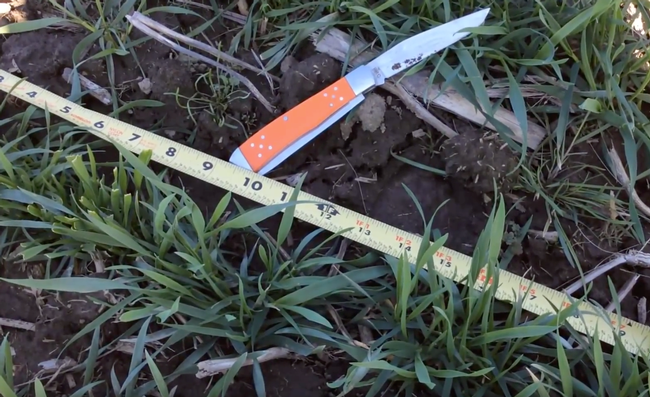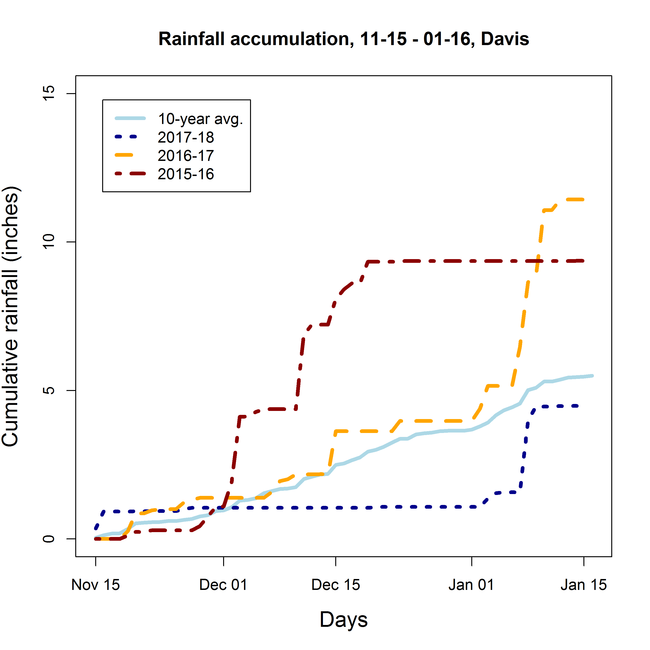After a dry beginning to the season, wheat growers might be trying to decide how to proceed with their nitrogen fertility program. If not irrigated, most wheat planted in the Sacramento Valley during November will likely have been stunted by the relatively dry conditions during the second half of November and throughout December (see Fig. 1, below). Some of the crops out there may need to be replanted entirely. If you're trying to work out how your stand is doing, consider some population sampling.
To get a rough estimate of your field's population, take several plant counts from random locations in the field. Lay a yard stick parallel to a row and count how many plants are still present in that row. Do this several times throughout the field and get an average. Multiply that number by 4 and divide the new number by your row spacing (in inches, typically 7).
Above: Checking wheat stand at tillering. Photo: University of Missouri Cooperative Extension
Example:
After counting several times, your average is 35.5 plants per 3 feet.
(35.5 x 4) / 7 => 142/7 => 20.29 => Roughly 20 plants per square foot.
Table 1: Relationship between plant stand and ideal yield potential adapted from Penn State Extension.
If your average comes out at less than 23 plants per square foot (or 1 million plants per acre) when you planted/planned for 1 million plants per acre, your crop yield potential would be less than 100%. At this stage of growth, the crop can make up ground by producing relatively more tillers than a full stand. But, you might need to adjust your fertilization plan to the lower than expected plant population. (Keep in mind, if you planted at a relatively low seeding rate for any number of reasons, your plant stand might not be the result of any significant losses due to moisture stress).
For example, if you were planning to apply 100 units of N at tillering you might consider decreasing that amount to match the reduction in yield potential. If your stand is down to 18 plants per square foot (roughly 75% yield potential), adding 75 units instead of 100 might make sense.
Figure 1: Cumulative Rainfall from estimated planting date for wheat in the southern Sacramento Valley
Timing is critical. If your plant stand is low, plants will respond by producing more tillers to fill the gaps as long as they have sufficient nitrogen available at this time to tiller aggressively. There are two scenarios to consider depending on whether or not you applied pre-plant N:
1) If you applied a heavy pre-plant application of N and have not irrigated, it is unlikely that the soil is deficient because the lack of rain this year would not have pushed much of the pre-plant fertilizer too deep into the profile. In this case you might wait a bit longer and decide on top-dressing based on soil N (See information on soil nitrate quick tests here and here and contact your UCCE Agronomy Advisor to assist with assessing this). If you applied extra nitrogen in a high-N reference strip, you can use it to monitor deficiencies that begin to appear as the plants are tillering.
2) If your stand is low and your pre-plant application was light to non-existent, consider additional N applications sooner than later with the idea being that you are trying to ensure that N is available as plants tiller and expand their canopy potential.
If your stand count is sufficient. You might wait a little longer until applying depending on the maturity and nitrogen status of your crop and soil. Applying at tillering with sufficient water following your application to incorporate your fertilizer into the root zone will mean that peak N availability will match peak N demand.
More information about determining nitrogen status and how to decide on top-dress N applications can be found here. In general, keep in mind that in-field tests vary in efficacy depending on several factors, but employing more measurement tools (soil N tests, green canopy measurements with a high-N test strip…) improves your chances of making an informed decision.


